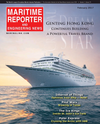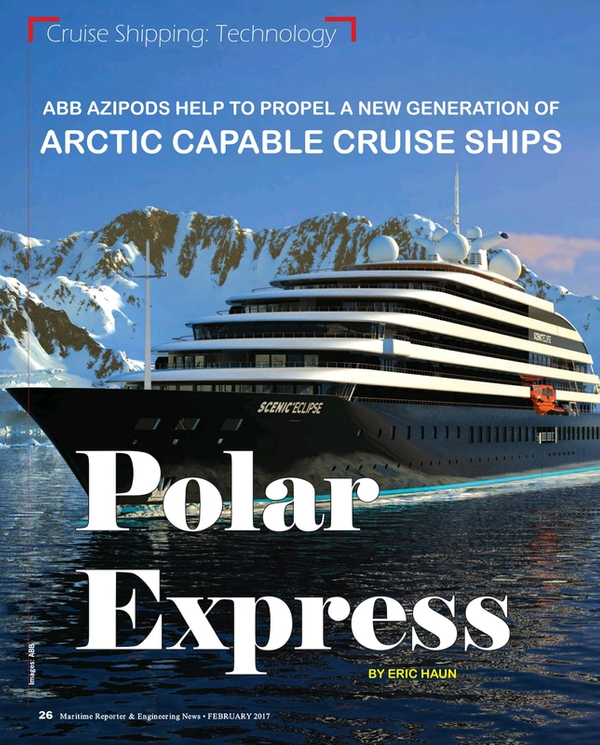
ABB: Propelling the Polar Cruise Boom
By Eric Haun
ABB Azipods help to propel a new generation of Arctic capable cruise ships
Leveraging its experience in the distinct polar and cruise vessel segments, ABB and its Azipod are at the forefront of the booming polar passenger vessel market. As world travelers continually seek access to more exotic and exciting destinations, evolving cruise shipping trends have triggered an order boom for passenger vessels capable of plying some of the most treacherous Arctic and Antarctic routes. Required for this class of ships is a range of equipment and technologies that enable safe and comfortable sailing through polar waters. Answering the propulsion call is ABB, a world leader within the polar and passenger vessel markets, whom Maritime Reporter & Engineering News recently visited at its Helsinki location, ABB Marine House.
ABB’s electric podded azimuth thruster Azipod has a 25-year history in the maritime industry, serving a large variety of vessel types ranging from cargo ships to offshore support vessels and drill ships. No stranger to icy conditions, ABB’s know-how for ice going vessels runs deep, and the company possesses a long supply history for cold water vessels. Currently there are more than 60 Azipod-equipped vessels in operation or on order for work in icy waters, including the high-tech LNG-powered Finnish icebreaker Polaris delivered last year, and SCF’s 299-meter heavy ice class LNG carrier Christophe de Margerie.
Likewise, ABB is no stranger to cruise and passenger ships. Azipods were first installed on a cruise ship in 1998, paving way for some 60 subsequent cruise ships to date, including the world’s largest: Royal Caribbean’s 1,187-foot-long, 226,000-gross-ton Oasis class ships. In the cruise market, ABB’s most recent Azipod order came from Genting’s Star Cruises brand, whose two new 204,000-gross-ton Global Class vessels due for delivery from 2019 are specially designed for the Asian cruise market.
Of all modern large cruise ships, icebreakers and high ice-class cargo vessels, roughly two-thirds are fitted with Azipod propulsion, according to ABB. “The main market for Azipod is large cruise and the opening new seaways in the north,” said Sakari Sorsimo, Senior Vice President, Head of ABB Business Unite Marine and Ports Finland.
Leveraging this presence and experience in both the polar and cruise segments, ABB is now positioned to serve an emerging class of polar and sub polar passenger vessels and has even launched a new Azipod designed specifically this market, the Azipod DO, which Sorsimo said is designed for “smaller, lighter ice class vessels,” and is available from 1.5-7.5 MW.
“We are designing [the Azipod DO] here in Finland, but manufacturing in China,” Sorsimo said. “And for this, we already have contracts for polar cruise vessels.”
In the expedition cruise segment, ABB currently has orders to supply Azipods for the world’s first passenger vessel to be constructed explicitly to Polar Code standards, and most recently the world’s largest expedition yachts with ice class.
The polar class passenger vessel Scenic Eclipse is currently under construction at Croatia’s Uljanik shipyard for Australia’s Scenic group and is due for delivery in August 2018. The 10-deck luxury cruiser will be outfitted with two 3 MW Azipod units, propelling the 168-meter-long, 16,800-gross-ton vessel through polar waters during the summer months. Scenic Eclipse will be classed by Bureau Veritas.
Three new 20,000-gross-ton expedition megayachts for Genting Hong Kong brand Crystal Cruises will each be powered by two Azipod units, enabling the Polar Class 6 luxury ships to navigate in icy conditions. The three Endeavor Class vessels will be built by MV Werften in Germany starting in 2017 and delivered in 2019, 2020 and 2021. ABB will supply the complete power, propulsion and automation package for these vessels, each classed by DNV GL.
“We are doing quite high ice class on the DO pod, so we have a unit that has to perform both in the ice and in the open water with extremely high comfort,” said Marcus Höglblom, ABB Vice President for Passenger Ship and Azipod Segment. “These vessels will be able to cruise anywhere in the world – from Antarctic to Arctic – for a very demanding customer.”
ABB AZipod DO
Power range:
- 1.5-7.5 MW per unit
Gearless power train
- Induction motor, or
- Permanent magnet motor
Hybrid cooling
- Up to 45% performance increase
- Up to 70% power without cooling
Electric steering
- 4 redundancy options
Adjustable strut height
- Minimizes / eliminates headbox
Shaftline proven technology
- Redundant seal
- Online bearing monitoring
(As published in the February 2017 edition of Maritime Reporter & Engineering News)
Read ABB: Propelling the Polar Cruise Boom in Pdf, Flash or Html5 edition of February 2017 Maritime Reporter
Other stories from February 2017 issue
Content
- Coral Reefs: A Unique Natural Resource page: 12
- Oily Water Separator Systems: Practical Advice page: 14
- Last Port of Call for the U.S. Merchant Marine? page: 16
- Inside Brazil's Cuise Slump page: 20
- Meyer Turku Builds Big page: 24
- ABB: Propelling the Polar Cruise Boom page: 26
- Interview: Tan Sri Kt Lim, Chairman, Genting Hong Kong page: 33
- Ice Kings: Model Testing Ship-ice Interactions page: 34
- How Eagle Bulk Shipping is Using Big Data page: 38
- Rolls-Royce Blue Ocean Team Looks to the Future page: 40
- Industry 4.0 on the High Seas page: 43
- Digital Tech Turning Around Marine Prospects in Uncertain Waters page: 43
- KVH Is On 'Watch' page: 46
- Offshore Innovation: A Real ‘Riverboat’ page: 48


